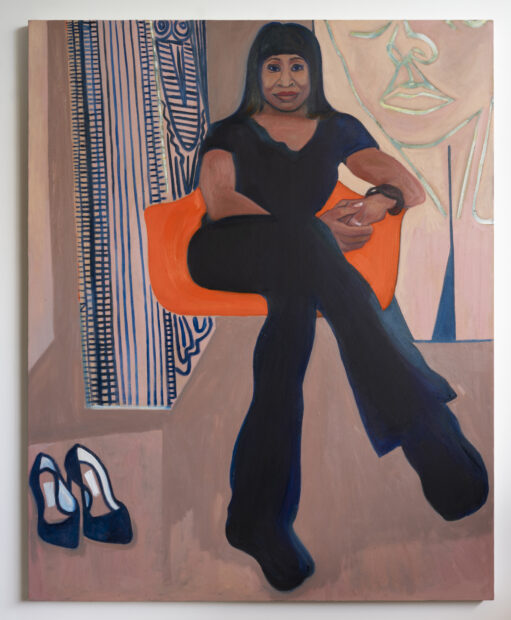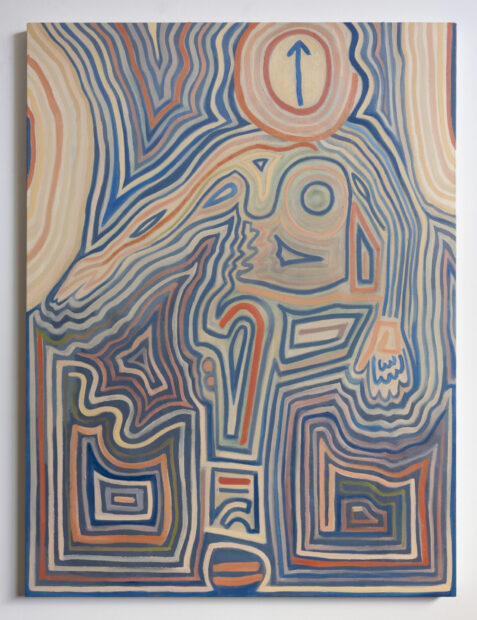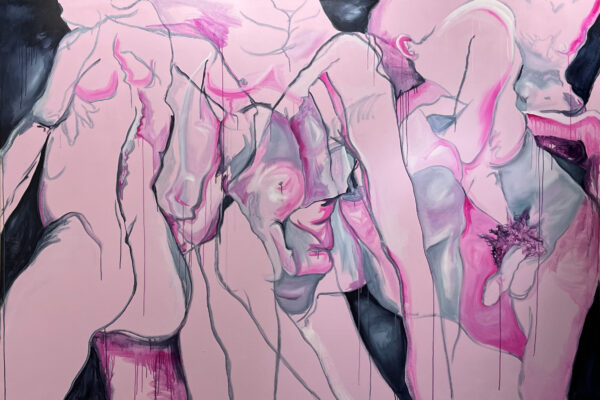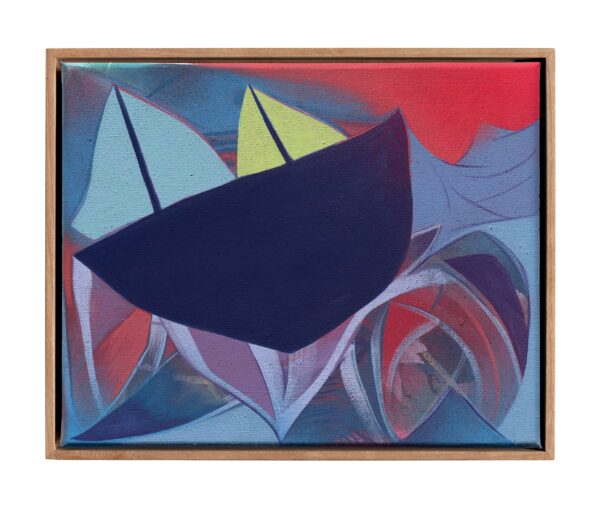
Doug Welsh “Lost wings floating,” 2023, house paint and spray paint on canvas, artist’s frame, 8 5/8 x 10 3/4 inches
The G5 Collective was founded by Liz Gates and Doug Welsh three years ago while they were in the MFA program at the University of Houston. The collective was named for the UH graduate art school building and parking garage that opened at the time, which was called G5. Their purpose, from the very beginning, was one of support and inclusivity. It was the height of the COVID19 pandemic, and most exhibition spaces were closed, so the group evolved as a way for them and their fellow graduate students to promote one another’s work and exhibit together. In addition, the collective committed to participating in at least one significant group volunteer project each year.
The members of the G5 Collective are Saran Alderson, Sarah Fisher, Liz Gates, Ashita Sawhney, and Doug Welsh, and their first exhibition as a group is now on view at the Jung Center in Houston. The title, Ignition, is a key part of G5’s mission statement: “We are a collaborative force for good, igniting positive action in the Houston art community and supporting each other without ego.” They have collaborated on various projects and promoted one another’s work, while also brainstorming innovative ideas to further their careers. G5 members have volunteered with the Orange Show, the Brooklyn Hi-Art! Machine, and the fundraiser Bearing Witness: Houston Artists Respond in Support of Ukraine at the Blaffer Art Museum.
The idea of a creative collective dates back to the merchant and craftsmen guilds in the Middle Ages. Art collectives share ideologies, aesthetic views, and common goals. More recent well-known art collectives include the Fluxus group, the Guerrilla Girls, Artists Anonymous, and Ant Farm, along with more localized Houston groups, like Otabenga Jones & Associates and Ruber: An Art Mob.
“Showing work as a group demonstrates our confidence in and commitment to each other and our collective sense of purpose,” the members write on G5’s website. “Sharing responsibilities required to produce a high-quality exhibition builds teamwork, trust, and connection.”
The Jung Center has always been a somewhat challenging venue in which to show artwork, but this installation of paintings, sculptures, and prints by five very different artists works quite well in the space. Liz Gates has the widest variety of pieces — from Safe as Houses (2023), a trio of freestanding “houses” constructed from cardboard and covered with diapers sewn together with embroidery floss, to Please Return (2023), a wall piece assembled with postage stamps stitched onto squares cut from furniture moving blankets, to Purple Flutter (2023), a monoprint stamped by pieces of deconstructed baby shoes.
Gates’ overarching theme is “Maternology,” a word she created to describe the investigation of the manifestations and dualities of motherhood. Although she still thinks of herself as a painter, she purposefully put down her paintbrush and turned to soft materials and objects from the home which are laden with symbolic and historical content. While raising her children as a single mother, she became sensitized to issues of under-appreciated domestic labor, as well as to the tension between the need to be responsible and the desire for rebellion. According to Gates, “Through repetition, rearrangement, and reinvention, I’m exploring the dichotomy between parenthood and individualism, as well as reimagining traditional objects as the symbols of motherhood.” She has succeeded in creating a new body of work that is both approachable and relatable, but without a trace of sentimentality.
Six of Doug Welsh’s small, abstract paintings hang throughout the space’s main hall, providing a lyrical interlude from the other artists’ work. Part of an ongoing series he calls Life Raft, these expressive arrangements are made while Welsh listens to music, a process he describes as “meditative and energizing.” Using house paint and spray paint, he creates imaginary worlds in which mysterious shapes interact with one another in front of semi-abstract backgrounds that suggest various things, including forests, gardens, oceans, and the sky.
Welsh shares that his partner and muse is represented by the green shapes in many of the paintings, while the artist himself is represented by the blue ones. In Lost Wings floating (2023), a black boat with blue and green sails is tossed about by massive waves under a fiery sky. Obviously, it depicts Welsh and his partner navigating the tribulations of life. Welsh states that painting is what keeps him resilient and on course, hence the series’ title, Life Raft.
Welsh’s palette and compositions are reflective of his emotions. Hands, trees, leaves, and other objects emerge from textured backgrounds of layered, interlocking geometric shapes. “The color and spatial relationships in my paintings can be lyrical, peaceful, disruptive, tumultuous, or tenuous, depending on my state of mind,” he says. “Ultimately, I seek balance in the interaction of these elements within my paintings and within myself.”
When one enters the Jung Center and looks down the main hall, Sarah Fisher’s In My Skin (2023) dominates the wall at the end. Fisher exhibits this and two other large portraits, as well as one sculpture. Although she constantly explores different mediums and techniques, portraits are the foundation of her art practice. The sitter in the powerful In My Skin (2023) is the retired Houston Ballet principal ballerina Lauren Anderson. Dressed all in black, she is sitting in a bright orange chair that appears to float above the ground. Anderson is depicted in Fisher’s studio, with two of the artist’s works of art visible in the background. On the right is a fragment of a self-portrait, while on the left is a large construction featuring one of Fisher’s beloved owls.
Fisher has been experimenting with abstraction and ambiguity. Her most recent painting in the show, nothing but movement just movement motionlines (2023), is somewhat of a departure. It is obviously a portrait of a woman, but the sitter has been deconstructed into a series of shapes and lines that vibrate with energy. Fisher’s sculpture, Disassociation IV (2023), is a freestanding construction made by etching clear pieces of interlocking acrylic with self-portraits. Inspired by the cardboard dividers used in liquor boxes, Fisher did an earlier version on a larger scale (which she showed at the Museum of East Texas) and hopes to use this piece as a maquette for future works.
Saran Alderson paints the human body and celebrates aspects of the body often deemed too unattractive or unworthy of attention. In her words, “My work hails to the glory of the fat roll, bows to the curl of body hair, and unearths accidental treats such as a heart-shaped scrotum or amoebic areolas to pay homage to the places where we all converge as humans.”
In the nearly 10-foot-wide painting Fleshy Business (2023), Alderson presents several standing figures in a friezelike composition. With the exception of a figure on the left, the bodies are so entwined that it is unclear where one figure ends and the other begins. There seem to be bodies of both sexes, as evidenced by at least one penis and one breast. Other fleshy elements are more ambiguous. Alderson channels early Willem de Kooning in her biomorphic shapes and unusual colors, as well as her drips and loose brushwork. She thins acrylic paint and applies it in washes of pink, which creates an effect similar to watercolor.
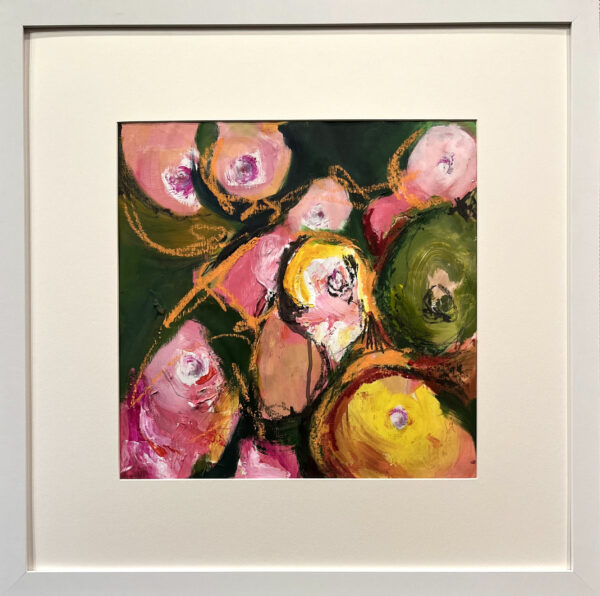
Saran Alderson, “Bloomin’ Bosoms,” 2023, acrylic paint and oil stick on red rosin paper, 16 x 16 inches
Alderson shows that she can also handle oil stick in the smaller Bloomin’ Bosoms (2023). Unlike her large painting, she builds up the breasts with circles of thick paint, using the stick as a unifying element with scribbled, looping strokes. The nipples seem to protrude from the surface of the rosin paper. Alderson is fearless and unafraid to tackle taboo subject matter as she presents new ways to explore the human form.
Designer Ashita Sawhney’s delicate, intricate sculptures are positioned on pedestals throughout the gallery. She has been investigating how people with limited color vision see the world. Color Blind Curriculum (2022) is a lenticular print that shows viewers how a traffic intersection, complete with red fire hydrant, street signs, and flyover freeway, appears to a person who is color blind. Viewed from different perspectives, the piece transitions from a full-color view to a limited-color view. According to the U.S. Equal Employment Opportunity Commission, approximately 18.4% of all U.S. adults have some type of difficulty seeing. The Americans with Disabilities Act (ADA) passed in 1990 prohibits discrimination against individuals with disabilities in all areas of public life and seeks to ensure that people with disabilities have the same rights and opportunities as everyone else. As a graphic designer, Sawhney wants to do more than ensure her work complies with the ADA; she seeks to have viewers experience what it is like to have limited color vision.

Ashita Sawhney, “Flower Stop,” 2023, from the series, “Color Blind Curriculum,” mini shopping cart and paper models (color blind view), 11 x 11 x 6 inches
Paper models of grocery carts explore three types of color blindness people experience when shopping for produce, cereal, and flowers. Flower Stop (2023) features a miniature shopping cart next to a display of flowers. Unlike the explosion of color one usually experiences in a grocery store flower display, these bouquets are limited to blue, purple, and dark green. Another cart in Moo Green Cerealously (2023) is loaded with cereal cartons, their colors limited to shades of green with pink labels. Picnic III—Brunch (2023), on the other hand, is a more extensive display of objects arranged in various containers that reveals what the world looks like to someone who is achromatic, that is, they cannot see any colors except black, white, and shades of gray. Sawhney uses these clever, intricate sculptures as a tool to demonstrate how people with limited color vision see the world.
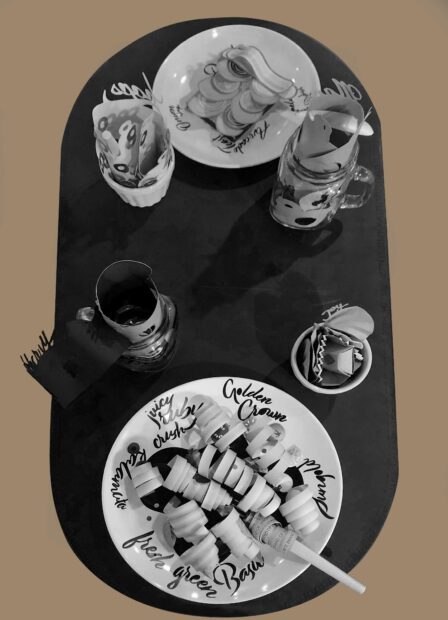
Ashita Sawhney, “Picnic III — Brunch,” 2023, from the series, “Color Blind Curriculum,” achromatic view with paper models on ceramic, glass and utensils, 33 x15 x 8 inches
The works of art in this exhibition are positive, accomplished, and thought-provoking. One can’t help but admire the way the G5 Collective members support one another, embrace inclusivity, and make a commitment to service. They have succeeded in one of their fundamental goals: producing a compelling exhibition by working as a team founded on trust.
Ignition is on view at the Jung Center in Houston through September 28, 2023.




